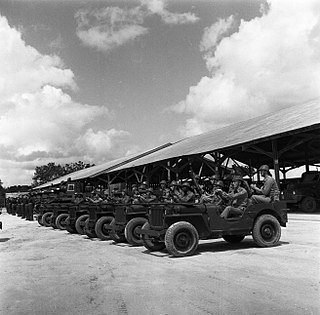
The Aluku are a Bushinengue ethnic group living mainly on the riverbank in Maripasoula in southwest French Guiana. The group are sometimes called Boni, referring to the 18th-century leader, Bokilifu Boni.

The Paramaccan or Paramaka are a Maroon tribe living in the forested interior of Suriname, mainly in the Paramacca resort, and the western border area of French Guiana. The Paramaccan signed a peace treaty in 1872 granting the tribe autonomy.
Mongondow, or Bolaang Mongondow, is one of the Philippine languages spoken in Bolaang Mongondow Regency and neighbouring regencies of North Sulawesi (Celebes) and Gorontalo Provinces, Indonesia. With more than 200,000 speakers, it is the major language of the regency. Historically, it served as the official language of the Bolaang Mongondow Kingdom.

Wanhatti is a village and resort in Suriname, located in the Marowijne district on the Cottica River. The resort is inhabited by the Ndyuka Maroons, and has a population of 468 people as of 2012. The village is primarily inhabited by Ndyuka of the Ansu clan or lo.

Cottica Lawa, often shortened to Cottica and also called Cotticadorp is a village in the district of Sipaliwini, Suriname. It is located in the east, along the Marowijne River and the border with French Guiana. The village has a school, and a clinic.
Henri Joannes Maria Claessen was a Dutch cultural anthropologist who specialised in the early state. He was Professor Emeritus in Social Anthropology at Leiden University, as well as an honorary member of several scholarly institutions ; Center for Asian and Pacific Studies ; Honorary Lifetime Member of the IUAES.

The Ndyuka people or Aukan people (Okanisi), are one of six Maroon peoples in the Republic of Suriname and one of the Maroon peoples in French Guiana. The Aukan or Ndyuka speak the Ndyuka language. They are subdivided into the Opu, who live upstream of the Tapanahony River in the Tapanahony resort of southeastern Suriname, and the Bilo, who live downstream of that river in Marowijne District.
Tabaru is a North Halmahera language of Indonesia.

Graman Quassi was a Surinamese physician, botanist and planter. Born in present-day Ghana, Quassi was taken to the Dutch colony of Surinam via the Atlantic slave trade, where he was initially enslaved on a sugar plantation before managing to emancipate himself. Assisting the Dutch colonial authorities in suppressing the activities of local maroons, he managed to rise to the top of the colony's small community of free people of color and eventually became a plantation owner himself. He gave his name to the plant genus Quassia.

Tamarin is a Ndyuka Maroon village on the Cottica River in Suriname. Tamarin was the place of the Catholic mission on the Cottica River, which operated a church, a boarding school, a clinic, and a sawmill. The mission was deserted during the Surinamese Interior War. Only the school is still in operation today.

Surinamese Maroons are the descendants of enslaved Africans that escaped from the plantations and settled in the inland of Suriname. The Surinamese Maroon culture is one of the best-preserved pieces of cultural heritage outside of Africa. Colonial warfare, land grabs, natural disasters and migration have marked Maroon history. In Suriname six Maroon groups — or tribes — can be distinguished from each other.
Hendrik Ulbo Eric"Bonno"Thoden van Velzen was a Dutch anthropologist, Surinamist and Africanist.
Wilhelmina (Ineke) van Wetering was a Dutch anthropologist and Surinamist. She was born on 17 October 1934 in the Dutch city of Hilversum. When she was 10 years old, her father (ironmonger) had been executed by firing squad in the Second World War because of participating in an illegal group who provided hiding places for people who were prosecuted by the Nazi-German army. She finished her secondary school in 1955, when she began her study of sociology at the University of Amsterdam. In her later career she continued her work at the Vrije Universiteit Amsterdam.

Granman is the title of the paramount chief of a Maroon nation in Suriname and French Guiana. The Ndyuka, Saramaka, Matawai, Aluku, Paramaka and Kwinti nations all have a granman. The paramount chiefs of Amerindian peoples in Suriname are nowadays also often called “granman”.
Bokilifu Boni was a freedom fighter and guerrilla leader in Suriname, when it was under Dutch colonial rule. Born in Cottica to an enslaved African mother who escaped from her Dutch master, he grew up with her among the Maroons in the forest. He was such a powerful leader that his followers were known as Boni's people after him. They built a fort in the lowlands and conducted raids against Dutch plantations along the coast. Under pressure from Dutch regular army and hundreds of freedmen, they went east across the river into French Guiana. Boni continued to conduct raids from there, but was ultimately killed in warfare.

Claudius Henricus de Goeje was a Dutch Navy officer and cartographer, who took a special interest in the Wayana and Tiriyó peoples he encountered on his expeditions to the interior of Suriname. For his lifelong interest in the Amerindian peoples of the Surinamese interior, he was awarded an endowed professorship in the Linguistics and Anthropology of Suriname and Curaçao at Leiden University in 1946. De Goeje retired in 1951 and died four years later, in 1955.
Daniel Anthony Overbeek was the last resident of Dutch Bengal between 1817 and 1825.
Henricus Franciscus von Söhsten, later anglicized to Henry Francis von Söhsten was the last opperhoofd of Dutch Coromandel between 1824 and 1825.

The Memre Boekoe barracks is a military installation in Paramaribo, Suriname. It was constructed during World War II as barracks for the American soldiers stationed in Suriname. It was originally named Kampement Gemenelandsweg. In 1950, it was renamed Prins Bernhard kampement. After the independence of Suriname on 25 November 1975, it was renamed Memre Boekoe barracks after Fort Boekoe, a fort used during the Boni Wars. It is currently used as the headquarters of the Surinamese Land Forces.













